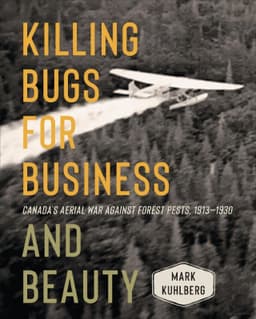
Book Review
Killing Bugs for Business and Beauty: Canada’s Aerial War Against Forest Pests, 1913-1930, 2022
By Mark Kuhlberg
Buy the book: https://utorontopress.com/9781487526474/killing-bugs-for-business-and-beauty/
From the introduction of a lumber staple feeding the insatiable British market in the early nineteenth century, to the development of pulp paper at the beginning of the twentieth, and to the interminable conflict over softwood duties, Canada’s forests have long been central to the country’s identity and economy. Trees were a strategic resource and protecting them was crucial for Canada’s prosperity. In his new book, Killing Bugs for Business and Beauty, Mark Kuhlberg looks at the country’s interwar campaign to defend its forests from destructive pests, ably weaving together a story of politics, scientific advancement, and business interests. This campaign would be seen as a huge success both at home and internationally as Canada became a pioneer in the burgeoning field of pesticide dusting by aircraft. Kuhlberg’s study is organized both geographically and chronologically, taking us from early attempts in Nova Scotia, through Québec and Ontario, to British Colombia, and spans from the Great War to the Great Depression.
The country’s aerial dusting campaign was a remarkable example of cooperation between numerous actors: the forest entomologists who identified the enemy and devised the poison necessary to defeat them; the politicians and bureaucrats, both federal and provincial, who spent public money on the campaign; and the logging companies desperate to protect their property. Kuhlberg shows that there was very little opposition to covering tracts of forest with dangerous chemicals; the conflicts that arose were always about location and cost. Two groups were loudest in demanding aerial dusting of pesticides: the timber industry, and environmental preservationists/recreationists. The motivation of the former is obvious, wanting to protect the valuable spruce and birch destined for the capital intensive and immensely profitable pulp paper industry. The latter group however based their demands on a desire to “protect” the beauty of the forests, making it “a moral issue instead of a financial one” (7). In doing this, they showed an idealized view of nature, as the forest insects were as much a part of the natural environment as their cherished hemlock trees. However, as Kuhlberg argues, sometimes these recreationists said the quiet part out loud and admitted that their interests in the beauty of the forests was largely about maintaining the value of their properties. In the end, Canada’s war against forest insects was largely about money.
Kuhlberg’s book is replete with military metaphors: forests are “under siege,” insects are subjected to “aerial bombing,” and aircraft are moved to new “theatres of operation.” These are quite appropriate; interwar Canadians believed they were waging a literal war against destructive pests that threatened their woodlands. In “a blatant attempt to engrave in the public consciousness the need both to fear insects and employ military technology to combat them,” Maclean’s magazine called this “The Greatest War of All” (36). The fight against insects such as the hemlock looper was undertaken using technology that came of age during the Great War, namely the airplane and chemical weapons. Furthermore, the incipient Royal Canadian Air Force was crucial in those early years, the aerial dusting campaign being used to justify the development of a peacetime air arm. These missions were extremely dangerous for pilots, often flying just above the treetops in aircraft unsuited for the task while breathing in poison dust in their open cockpits.
Kuhlberg’s argument about the remarkable “level of cooperation among different levels and branches of government and industry” will be of particular interest to business historians (97). Both timber companies and property owners had little difficulty in getting their demands for aerial dusting heard by politicians, and internal lobbying would often decide whose trees would be dusted. Kuhlberg notes that while wealthy property owners in Muskoka succeeded in having public funds spent to dust their trees, similar pleas from working class residents of Brockville fell on deaf ears. This example is illustrative of the crucial class dynamics at work, where “beautiful trees were not created equal, even when they were the same species and appreciated in the same way for their aesthetic qualities” (196). It would perhaps have strengthened the argument had this episode been discussed earlier in the book rather than in its conclusion. The reader is left wondering if there are other examples of working class communities that were denied the aerial dusting being carried out on the public dime for wealthy cottagers and powerful timber firms, but this is a fairly minor quibble. Another important insight is the influence of American pulp paper companies on the Canadian economy, something also explored by Michael Stamm in Dead Tree Media (2018). American firms frequently lobbied the Canadian government to conduct aerial dusting operations to protect their investments. Kuhlberg notes a particularly complex example of this influence, where the Oxford Paper Company of Maine asked, “that an American scientist […] employed by the US government conduct a study in Canada on behalf of an American firm operating in Canada even though the dominion government employed its own coterie of forest entomologists who were already involved in studying the matter in question,” a request that was granted (52).
In sum, Kuhlberg has told a fascinating story of Canada’s early efforts to protect its forests from the insects it considered an existential threat. It is a deeply researched work highlighting a little- known chapter of the country’s history. Killing Bugs for Business and Beautymust also be commended for being a very readable and often highly entertaining tale, with numerous colourful characters interspersed in its pages. It will be of great interest to historians interested in the complex interaction between government, science, business, and the natural environment.
Jean-Philip Mathieu
McGill University